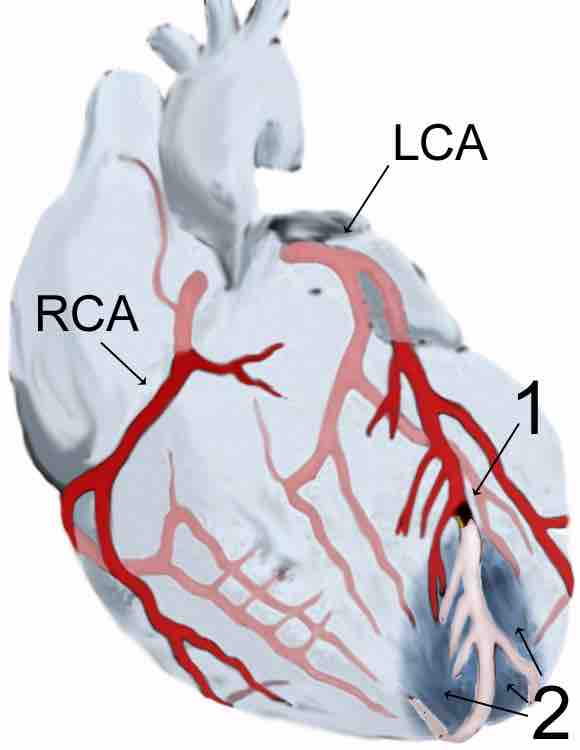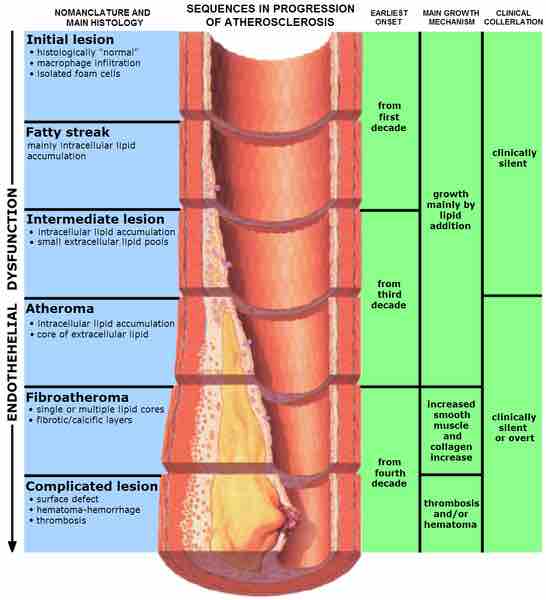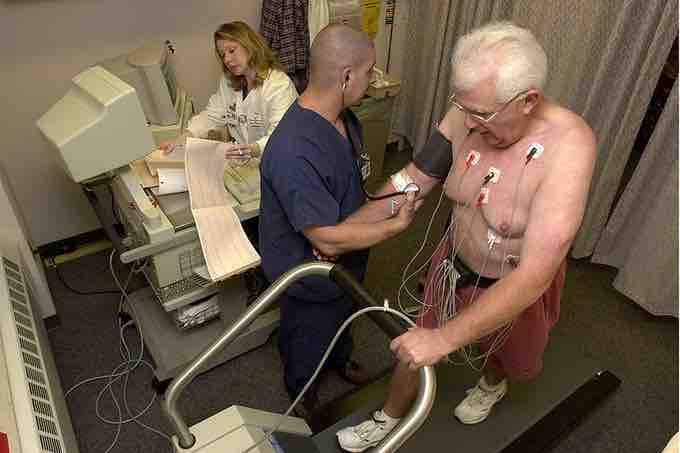Ischemic heart disease (IHD), or myocardial ischaemia, is a disease characterized by ischaemia, or reduced blood supply to the heart muscle, usually due to coronary artery disease and myocardial infarction. Coronary artery disease is the narrowing of the heart arteries due to atherosclerosis, the deposition of fat on the walls . If these deposits come loose, they can cause a clot that will block blood flow to the heart muscle, causing a myocardial infarction . The risk increases with age, smoking, high cholesterol levels, diabetes, and high blood pressure, and is more common in men and those who have close relatives with ischaemic heart disease and a history of myocardial infarction. It is the most common cause of death in most western countries, and a major cause of hospital admissions.

Acute myocardial infarction
The diagram depicts a myocardial infarction (2) of the tip of the anterior wall of the heart (an apical infarct) after occlusion (1) of a branch of the left coronary artery (LCA). Right coronary artery (RCA).

Atherosclerosis
This diagram depicts the progression of atherosclerosis in a blood vessel. In coronary artery disease, these atherosclerotic plaques build up in the coronary arteries and rupture may lead to ischemic heart disease and myocardial infarction.
Symptoms
Symptoms of stable ischemic heart disease include angina, which is characteristic chest pain on exertion, and decreased exercise tolerance.
Ischaemic heart disease may be present with any of the following problems:
- Angina- chest pain on exertion, in cold weather or emotional situations
- Acute chest pain- acute coronary syndrome, unstable angina or myocardial infarction
- Heart failure-difficulty in breathing or swelling of the extremities due to weakness of the heart muscle
- Heartburn
Diagnosis
Ischemic heart disease is typically associated with an underlying specific heart disease.
In "stable" angina, chest pain with typical features occurs at predictable levels of exertion. Various forms of cardiac stress tests may be used to induce both symptoms and detect changes with electrocardiography (EKG), echocardiography (using ultrasound of the heart), or scintigraphy (using a radioactive marker to examine blood uptake by the heart muscle). If part of the heart seems to receive an insufficient blood supply, coronary angiography may be used to identify narrowing of the coronary arteries and suitability for angioplasty or bypass surgery.

Cardiac Stress Test
A patient undergoing a stress test. This test examines blood flow to the heart during exertion, and can be used as a diagnostic tool in ischemic heart disease, coronary artery disease, and heart failure.
Diagnosis of acute coronary syndrome and myocardial infarction generally take place in the emergency department when a patient presents with acute chest pain, combined with shortness of breath, nausea, vomiting, palpitations, sweating, and/or anxiety. An EKG is performed, looking for changes that are characteristic of a myocardial infarction. In the absence of these characteristic markers, heart damage is detected by cardiac markers in the blood that identify heart muscle damage. If there is no evidence of damage or infarction, a diagnosis of "unstable angina" is given. Depending on the risk assessment, stress testing or angiography may be used to identify coronary artery disease in these patients.
In patients with heart failure, stress testing or coronary angiography may be performed to identify and treat underlying coronary artery disease.
Causes
The disease process underlying most ischemic heart disease is atherosclerosis of the coronary arteries, which decreases blood flow to the heart muscle. Atherosclerosis is the thickening of the artery wall as a result of plaque formation, which is the accumulation of fatty materials such as cholesterol. Atherosclerosis reduces blood flow to the heart muscle, causing ischemia. When these plaques weaken, they can develops a tear, which forms blood clot that obstructs blood flow, causing a myocardial infarction.
Treatment
Treatment of ischemic heart disease is dependent on the underlying disease process. In stable IHD, antianginal drugs may be used to reduce the rate of occurrence and severity of angina attacks. Treatments for acute coronary syndrome and myocardial infarction include coronary angioplasty, treatment with thrombolysis "clot buster" medication, and coronary bypass, where narrowed blood vessels on the heart are replaced.
Various treatments are offered in people deemed to be at high risk of coronary artery disease. These include control of cholesterol levels in those with known high cholesterol, smoking cessation, and control of high blood pressure.